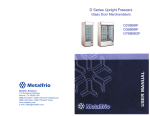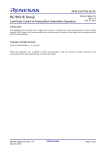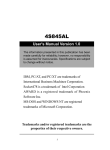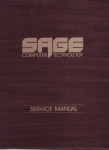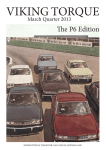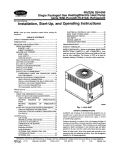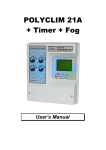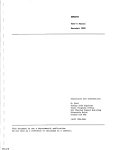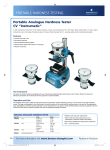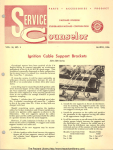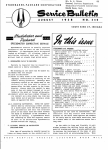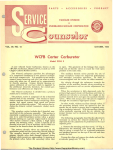Download Packard Service Counselor, Studebaker-Packard
Transcript
PARTS. r---=::::==::::::-;::::::;-' ACCESSORIES· PRODUCT PAC KA R D MOT 0 RCA R COM PAN Y VOL. 28, NO. 11 NOVEMBER, 1954 Twin Ultramafic Transmission The official name for the Gear-Start Transmission is "TWIN ULTRAMATIC TRANSMISSION" and will be referred to as such in all future service publications. Most all of the zones have completed the Twin Ultramatic Transmission schools with their dealers and according to reports, the service training panel covering the hydraulic system was highly received by the mechanics. 61 traffic and highway driving. After the engine and transmission are thoroughly warmed up, and the non-standard operation noted, make a hydrauHc pressure test as outlined below: HYDRAULIC PRESSURE TEST To diagnose and isolate the cause of the faulty operation a pressure test should be made of the following hydraulic units: (1) (2) (3) (4) (5) (6) (7) (8) This type of service training aid is planned for future schools wherever it can be applied. We feel that a better understanding of any and all units of the car will result in a more accurate diagnosing of complaints and better workmanship which means quicker and better repair jobs for the Packard owners. Front pump pressure. High range clutch pressure. Low brake top pressure. Converter in pressure. Converter Out pressure. Direct drive clutch pressure. Governor pressure. Throttle pressure. CEAR-ST.>\.RT IJL.TIlA .\ IATIC TRA1~S-'IISSI0N PHr.SSURE TEST FORMS Pictured are schools held recendy by the Los An· geles Zone. Twin Ultramatic Transmission fro,,' Puml' 11)-fllO 1I/,~I_AII &I""or """itl""" R~od,nR' HYDRAULIC TESTS • P p,,,,t">n__ l~ In 2G ~1P1t-full Ih",I,I. bof",. 0""" 0"" •• n~.g<>--~b •. P"..~".c _Hc.d,n~~ Hydraulic pressure tests are a most important factor when diagnosing automatic transmission com~ plaints. n' P,,,;\l.," __ rull ,"~,"J<. ""f~,. O,,~".:C'>-:>l.'<. !,,,,,,,u,.~ nor"" Pd,-. _R">"'n~ H,,"I~ Il,~h R,n~c <.:1"1.<11 (21_Pf""'"r~ .I-.IJ be "f ",,' m"", In;," IU II:>. UnO., pump • n p,,.,,,,,,,. If a complaint or trouble is not definitely located or established, do not disassemble the unit until the oi1level is checked, the car road tested and a hydraulic unit pressure test is made. Too many times a unit is disassembled. and when the inspection is made the cause of the complaint cannot be found , because the clue or evidence of the cause has been lost or destroyed. 1'1' ",,00 RP~1 ,R.aomc_ il,HI ll ..... m. P'''''''C HRCP ~ '0 1'... "" .. _ I~ 10 ZII ~IPH C"'''~ft.r Pm'" _H<adh"~ ~ U' P'~,"on IlPM .I<J(l 1I •• d,nl. ti\,~ p' l\.. i'MI_ZQ MPH_D.",." S:o.dy lhron'" -------u- Dr;,', R.od,n~ Ik, ~. TO!> 13)- 1'1 ..... '" ,hoold b< ,I", .. m" ~"t m., .. ,h.n lQ It.. "m"', 1"''''1' " ..... u,. l.ow 1'1' Dr L n.TP 'D P,,,,,;,o>---VHl RP~'_R"odm~ ~\I-'_ ~ D' 1""''''''11--"100 R!'M_H<lUl"'~ -----r- D' Pus,'"'' Imme<H.'~I)· An" UI"M, _R<.don~ ~ . In many instances, " come backs" could be avoided if a hydraulic pressure test was made after the work was completed. for example: a certain part was replaced, but the cause of the failure was not deter~ mined. Make a pressure test, it may give you the cause which should be corrected thus avoiding a repetition of the trouble. !l,,«1 Om"o 16) Pr ...... , •• oo..ld b< ,he Am. 0< M' m",.., ,h.n IQ II» "..,!.r pomp P""'''''' n ' !'. .. ,hun 15 t" IS Mrli 1'1" 001' -R •• d,n1l<ij.iW """""'Q"" Gov.'nor (71-13 MPH Co.,,'orl« In fil-tOO RPM U' 1'",,,,,,,, _l! •• djn~ ' ~MPH "!lefor. Dtr""t Om"'-_H •• d,"~ _R=lin~ MPH _R'NI",~ 5E MPII -RudJng~ RP~' _Readln.~ ~ Th",tII. 181_400 _ 11~",hn, ~72 Yull ThroItJ. Vir"" Oli,'. r" g-.r"<l -R<>d"" ,u:B""' K"kdQwn _R C'd"'~_ _R.ad'n,~ C"""e,'", 0..1 I;)-D ' P""II.,n I~ 10 II MPH CW"'e,'e, Dr,,,, -R"d,"l~ No'., R<d n~"r .. IndIO.'. «1,",«1 p,"",r .. 'I) ""''';on :0;,." Gear 5,.,t. 0 ' 1'00,,.,,,,,· Go" SI.,I. t"!~P~""" """"",ng '<m~ra' ,ok..., .1 11<1"".1 FLUID LEVEL The fluid level should always be checked and brought up [Q the full mark before any diagnosis is made. Low fluid level can be the cause of many complaints ranging from excessive noise to a noticeable slip in any or all of the operating ranges. Fig. 1 NOTE: When making pressure tests, use th e pressure fest forms shown in Fig. 1. The figures below the lines on the form indicates correct pressures. ROAD TEST After the oil level is brought up to the full mark, road test the car to determine if correcting the oil level has corrected the complaint. The road test will also warm up the engjne and transmission to operating temperature necessary to make an accurate pressure test. TOOLS The necessary special tools required to make a complete hydraulic pressure test on the Twin Ultramatic Transmission are: PK·23 Drive the car with frequent stops and starts, at low speed, accelerating, and~at medium ~1 speeds, similar to the conditions that would exist in driving in heavy Special Test Pan Adapter, Throttle Pressure Adjusting Wrenches and Gauge Hose Extensions . PU·300 Three Gang Pressure Test Gauge. 62 PREPARATiON 4. Direct Drive Clutch-Conve rter In-Converter Out. 5. Direct Drive Clurch-Governor-Co nverter In . As most of the pressure tests are taken with tbe car in motion at various speeds, the gauge should be in the driver's compartment where it can be seen while driving. CONVERTER OUT PRESSURE To ta ke the converter out pressure, a special tee connection will be required. Install and braze a Ys" male nipple into one end of a YsII tee. Remove the flexible tubing from the left fresh air duct, thread the gauge hoses through [he left fresh air grille, out of the air duct and down to (he trans· mission . "See Fig. 2 for location of the pressure test take-off poinrs." o 0 '~ o (U PPER FITTING) 8 --+--Ho Remove the upper oil cooler tube adapter from the side of the bell housing and install the special tee connection in the bell housing. Install the oil cooler tube adapter in the tee and reconnect the cooler cube. t'See Fig. 3." Connect a gauge hose to th e tee connection. 7 THROTTLE PRESSURE AND LOW BRAKE TOP PRESSURE o The throtde pressure and low brake top pressure test take-off points are located on the control assembly. "See Fig. 4 ." To m a ke these tests, follow the procedure outlined: BonOM VIEW Fig. 2 Three pressures can be taken at one time; therefore; study the nature of the trouble [0 determine (he combination of pressures that may be at fault. Suggested list of pressure test combinations without removing the transmission oil pan: 1. Front Pump-High Range Clutch-Converter 10. Fig. 4 2. Front Pump-Direct Drive Clutch-Converter In. 3. Front Pump-Converter In-Converter Out. (a) Drain the oil, remove the transmission oil pan and screen. 63 (b) Install the test pan adapter and gasket with the adapter elbow tube on the left side and toward the front of the car. The throttle pressure should be 23 lbs. at 400 RPM with the oil at operating temperature. The throttle pressure ad justing SCrew is shown in Fig. 5. It can be adjusted by removing tbe rubber plug in tbe adapter and using the two small wrenches through the opening as shown in Fig. 6. Be sure to recheck the pressure after the adjusting SCrew lock nut is tightened. Thread two of tbe gauge boses through the elbow tube on rhe adapter. (c) Remove tbe Ys' pipe pluff "A" from tbe botlom of tbe low brake and install a Ys' elbow in this opening. Connect one of the gauge hoses to the elbow. Suggested list of pressure test combinations with gauges connected to the control body: Remove the Ys' pipe plug "B" from the tbrottle valve body and install a Ys' elbow in this opening. Connect the other gauge hose to this elbow. 1. Throttle-Low Brake Top-Higb Range Clutcb. 2. 3. 4. S. (d) Install the two oil sucdon tube extensions as shown in Fig. 4 and install the oil pan and gasket, Reinstall the oil that was drained out or the same amount of new oil. Throttle-Low Throttle-Low Tbrottle-Low Tbrottle-Low Brake Top-Direct Drive. Brake Top-Governor. Brake Top-Frnnt Pump. Brake Top-Converter In_ After the pressure tests have been completed and the readings posted on the pressure test form, com· pare your pressures with those on the test form. Careful study of the pressures in conjunction with tbe hydraulic cbarts will greatly aid you in diagnosing troubles. NOTE: The tbrottle pressure is a very important pressure as it controls most other pressures in the system, controls upshift, clutch engagements and disengagements. Therefore, it is important that thronle pressure be accurate. Voltage Regulator Testing Procedure DELCO-MODEL 1118829 5402-06-11 -13-26-31 Field reports indicate that the importance of checking the voltage setting of Model 1118829 type regulatOrs with a batte,.y ill the circllit is nOt fully appreciated by all concerned. The Model 1118829 type regulators do not include a acceleratOr or "kicker" coil on the voltage regulator unit. As a result: the rate of armature vibration is slower than that of earlier types and tbe ·voltage setting call be clucked accllrately only wbell a battery is c01mected ill the cha,-gillg circllit. For this reason~ it is specified that voltage regulator checks on these regulators be made with a fixed .k.J:·ohm resistor of not less than 25 watts capacity connected in series with the battery. Fig. 5 THROTTLE PRESSURE ADJUSTMENT ,Before attempting to adjust the throttle pressure, cbeck all of the throttle linkage adjustments as described in the "Maintenance Section " of your Gear· Start Ultramatic Transmission Training Booklet. If Model 1118829 rype regulators are checked by using a U ·ohm resistor in place of the battery (as was previously recommended 01..1 earlier models), the indicated volhlge settiug will t . d to be erratic and alw(J.Ys will be comiderably lowe,. tball tbat obtained with ~t battery ill tbe circllit. The use of a fixed 7;(·ohm resis[Qr connected in series with the battery is entirely satisfactory for checking the voltage regulator setting 011 bot/; old ~lI/d lIew type regulators in eirher 6· or l2·volt models. Headlight Aiming The AMA specifications on head lamp aiming has been changed in respect to rhe height of the light beam. Please make this change on page 22 "Electrical Section" of your Service Manual. In the 2nd para· graph under "Head light Aiming", change 3' dimension to 2". Fig . 6 64 PRINTED IN U.S.A.




